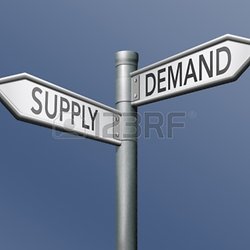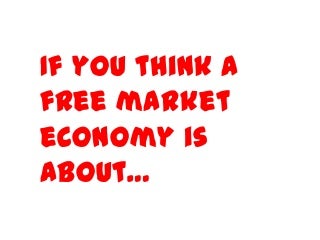 The present political economic system of the Philippines, dubbed as Sturdy Republic” and inaugurated last July 22, 2002, reinforces its being as a blended economic system. Free and honest trade between international locations creates incentives for the efficient allocation of sources. Larger levels of production create more jobs and more wealth for both international locations. Nonetheless, the tangible benefits of the free market may be adversely affected by improper government interference. Unfortunately, China’s communist government has a proclivity for constantly distorting market forces by way of government subsidies, preferential loans, and forex manipulation. As a result of China has failed to totally implement free market reforms to its economic system, the United States and other WTO nations should continue to treat China as what it is: a Non-Market Economic system. These initiatives have led to overcapacity in the world steel market and have been detrimental to American steel producers. Such universal market data by every participant is solely taken as a right.
The present political economic system of the Philippines, dubbed as Sturdy Republic” and inaugurated last July 22, 2002, reinforces its being as a blended economic system. Free and honest trade between international locations creates incentives for the efficient allocation of sources. Larger levels of production create more jobs and more wealth for both international locations. Nonetheless, the tangible benefits of the free market may be adversely affected by improper government interference. Unfortunately, China’s communist government has a proclivity for constantly distorting market forces by way of government subsidies, preferential loans, and forex manipulation. As a result of China has failed to totally implement free market reforms to its economic system, the United States and other WTO nations should continue to treat China as what it is: a Non-Market Economic system. These initiatives have led to overcapacity in the world steel market and have been detrimental to American steel producers. Such universal market data by every participant is solely taken as a right.
Some economists have estimated as many as 19,000 U.S. steel and iron employees are actually on the lookout for a new job on account of Chinese market manipulation. Granting China Market Economic system status would only exacerbate the problem by allowing their artificially low-cost steel to flood the market. Doing so would as nicely send a message of weak point and capitulation to our other trading partners who have also been proactively engaged in market exploitation. Another, usually missed, side of Chinese market interference is the potential threat to our national security. If U.S. steel production is hollowed out by unfair Chinese competition, the U.S. could possibly be placed in the susceptible position of having to rely on international international locations for important commodities. Now just isn’t the time to affirm unhealthy practices by way of granting China Market Economic system status. A pure market economic system, or capitalist system, is one perfectly free from external control.
Patrons and sellers enter into transactions without coercion or control from any exterior forces, and market competition for both patrons and sources arises naturally. The alternative of a market economic system is a planned economic system, also known as a command economic system. In the course of the twentieth century, both China and the Soviet Union had been examples of enormous planned economies during which the government controlled many features of production and pricing. In 1978, China began transitioning steadily in direction of a market economic system by allowing the market to dictate pricing in some sectors while retaining government control in others. Despite these and other problems, market economies come with many advantages, chief among which is pace.
This dual or blended economic system strategy has over the past quarter of a century made China the fastest-growing major economic system on the planet. In the United States, as in most economies, there is a steadiness of free market forces and essential governmental controls. So in such a market kind, any seller who tries to hike the value will simply damage his client base.
Examples of government intervention in the U.S. economic system embody the nationalization of rail travel (Amtrak), laws in opposition to drug use, and the protection of property rights. Citing the provisions in the ‘Protocol on the accession of China to the WTO’ in 2001, Beijing has mentioned WTO member international locations must fulfil their promise to deem China a ‘market economic system’ from December 2016. As of now, India is non-committal” on according MES to China, the sources mentioned, adding that in the end will probably be a political call after considering the stance of other international locations and India’s relations with China. Let us try to understand these completely different market varieties with examples from the true world.
